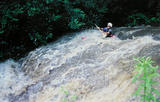
Tuckasegee River Update and Video (NC)
Recreational releases on the Upper Nantahala and West Fork of the Tuckasegee are currently being held up by a local County's opposition to removing Dillsboro Dam on the Tuckasegee River. Based on the dam relicensing settlement agreement that AW, Duke Power, and many local and regional groups signed, the removal of Dillsboro Dam must be certain before the releases and other mitigation will be initiated. Releases should have begun in 2006.
Jackson County opposes removal of the 100 year old, 12 foot tall, inoperable dam. They currently have several strategies they are pursuing to block the dam removal. First, they continue to push the Federal Energy Regulatory Commission (FERC) to side with them against removal. FERC has squarely refused at every turn. Second, they have filed a legal challenge of FERC’s decisions which is pending review. Third, they have formally appealed the State of North Carolina’s approval of the dam removal, which will go to a hearing on October 27th. Lastly, they have threatened to take the dam from Duke Power by eminent domain. American Whitewater believes none of these challenges has any merit. However they have, and will, delay the virtually inevitable removal of the dam.
What this means for paddlers is another year or two delay. It appears likely that 2010 will be the magic year – one in which Dillsboro Dam is removed, new river releases are provided, access areas built, and money is put to work protecting the river corridor.
As Dillsboro Dam on Western North Carolina’s Tuckasegee River gets ever closer to being removed, river restoration opponents are beginning to target their discontent at several recreational releases planned for the West Fork of the Tuckasegee.
Jackson County Manager, Ken Westmoreland, was recently quoted in a local newspaper article
claiming that releases raise the river 6-8 feet (Actually its 2-3), encroach on private property
(actually releases are less than natural bank-full flows), and that paddling would require the
County to rescue people. “We are unwilling to do that at public
expense,” Westmoreland said. “We are saying ‘we think this is a foolish idea
but if you go forward with it and we have to spend money for rescue, somebody ought to pay for it
other than the public.”
This article spawned an erroneous letter to editor last week from Mike Bamford, a vocal opponent of paddling on the nearby Upper Chattooga, where he is associated with a large private landowner opposed to public river access. AW responded this week with a letter of our own.
Once the Dillsboro Dam issue is resolved, we will increase our efforts to provide proper
management of the Class IV West Fork of the Tuckasegee releases and access. We’ll need paddlers to help build a hiking/put-in trail into High Falls
which may occur next fall (09). Duke will improve parking with some
gravel and possibly some grading. For now, paddlers can enjoy
watching the 2001 flow study video which we recently posted to Youtube. Please note that the first 3/4 of the video was filmed at slightly lower water
than the selected flow. Confusingly, the second flow on the video was labeled 350cfs on the
video and was actually 250cfs, which was found to be the optimal flow. Also, the water was
muddy in the video because no releases had occurred in many years.
Once releases start, the water will clear up quickly like Tallulah and the Cheoah. For now, the river is totally dewatered.
Enjoy the video!
